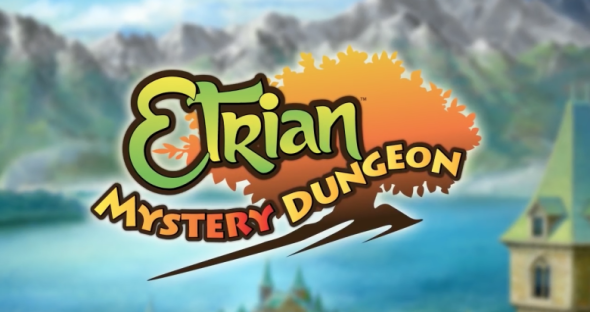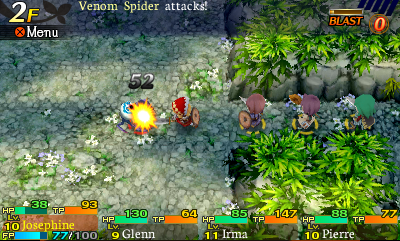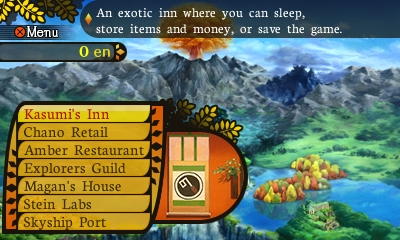
Developer: Spike Chunsoft, Atlus
Publisher: NIS America
Platform: Nintendo 3DS
Tested on: (New) Nintendo 3DS
Etrian Mystery Dungeon – Review
Etrian Mystery Dungeon is a game very much comparable to Persona Q. Both games take two well-established RPG series with entirely different gameplay and storytelling, and merge them together forging a title which has a surprising amount of enjoyment to it. Persona Q took the beloved Etrian Odyssey first person dungeon crawling and added Persona to it, creating an Etrian Odyssey game with a lot of story, which the main titles missed. This time around, in Etrian Mystery Dungeon, we’re saddled up with Spike Chunsoft’s Mystery Dungeon gameplay, made popular in the Pokemon Mystery Dungeon series, and an Etrian Odyssey class and skill system. Once again, these two franchises have complete different styles of gameplay, yet it works together surprisingly well.
Story
Although Persona Q focused heavily on its story, Etrian Mystery Dungeon doesn’t really put that much effort into it. This is rather unsurprising, as both of its parent titles also don’t rely too much on storytelling. The game simply revolves around you, an aspiring adventurer, travelling to the town of Aslarga, seeking its famed number of dungeons. Once arrived, you form a guild, and start exploring. It’s as simple as that.
Later on you’re tasked with helping Aslarga develop, and although this is optional it is greatly advised as it adds higher functionality to certain areas in town. Other story elements come in the form of numerous missions you can choose to take on. These house small recognisable storylines which RPG veterans would be very accustomed to, and offer an XP and/or money reward.
Graphics
As is the case with most Etrian titles, the graphics of Etrian Mystery Dungeon are stunning. It seems as though every single colour possibly achievable on the 3DS is being used, as environments are colourful, full of life and variety. Every dungeon has a set theme, and each has subthemes. Surroundings change the deeper your party goes into the dungeon, creating a sincere feeling of exploration.
Outside of dungeons the town and characters are represented through 2D illustrations, only changing slightly whenever a character’s mood changes. Environments are rich in design, and characters have a lot of personality, represented also through their scripts.
Sound
As with most Role-Playing Games, the soundtrack of Etrian Mystery Dungeon seems orchestrated, and provides a solid basis for exploration. It is neither boring nor repetitive. The only side effect is that the score isn’t very catchy. Not once have I found myself humming along to one of the numerous tunes. This might be due to the sheer amount of tracks. Every dungeon houses several pieces, and every area in town has its own tune.
Redundancy isn’t an issue when it comes to sound design, if the track loops at all it is unnoticeable. The same goes for the game’s sound effects. No amount of slicing and dicing results in bleeding ears.
Gameplay
This is truly where Etrian Mystery Dungeon shines. Along with the beautiful presentation of this RPG comes an incredibly well thought-through turned based combat system, which proves to be quite a challenge. Although at first most systems seem simple, putting the explanation into action requires quite a bit of strategy. The game makes every turn in combat count, meaning that a single turn can result in complete failure. Therefore it is important that the player is in control of all four party members.
A leader system is set in place, though, forcing the player to be in control of only one character at a time, with boss battles as an exception. Changing leader can be done instantly, and is quite the necessity if the player wants to come out victorious. Party members will act out of own free will, such as healing when a character is low on health, but also results in aggravating moments when you don’t want a party member to do this. Luckily, this can be turned off in the game’s settings, resulting in the game asking if you agree with the AI’s decision. This is only one of many aspects that prove that people have sat down and thought about this game seriously. If a certain system or functionality is not to your liking, you’ll probably be able to turn it off in the settings.
When fighting monsters, completing missions or reaching the end of a dungeon, all party members are rewarded with XP. As expected, once a certain party member gains enough XP they’ll level up and gain several skill points. These can then be exchanged for skills, which broaden the character’s arsenal of moves, attacks or attributes. All skill trees are linked to their respective classes.
There are eight classes in total, all with a different key function in a party. Only four characters are allowed in a party at a time, meaning that the player has to make a choice. If you struggles with choosing skills or forming a party, the game has an option to help out. In the case of skills the game will automatically assign skill points to the most appropriate areas. Next to that, the game will advise beginner parties, advanced parties or how to spread out party members according to play style when you don’t know which team mates to pick. All of this can be managed in the town of Aslarga.
The town holds the role of a central hub, where the player can, among other things, buy items, store items or money, ask for advice, accept missions, and manage party members. Storing items or money is advised, as the game will punish the player severely if they die inside of a dungeon, as it will take away all of your items and money. The town has no real recreational value, and serves purely as a practical area, where no time is wasted.
One interesting mechanic arises slightly later in the game, which plays with the border between dungeon and town. This comes in the form of DOEs, which are large monsters who’ll try to escape into town and wreak havoc. This is quite a refreshing system, as the border between dungeon and town is very noticeable. The distinction starts blurring, making for an interesting mechanic.
One of the game’s downfalls is that gameplay soon gets repetitive. Aside from the severe difficulty curve not much differs gameplay wise. This is partly due to the lack of story, as it is often the driving force for players who want to know how it all ends. Sadly, the aforementioned difficulty curve also forms a barrier to the game’s enjoyability. An example of this is the introduction of missions just before the second dungeon. Once accepted, the game tells you that said dungeon, which I hadn’t even explored yet, is now harder and filled with traps, making it unbeatable on the first or even second trip.
Conclusion
Etrian Mystery Dungeon is a beautifully designed, well thought-through mixture of two RPGs that shouldn’t have worked together. Alongside a deep skill and class system, strong turned based combat and beautiful graphics, the game suffers from redundancy, lack of story, and a steep learning curve, which might scare off unaccustomed players. For fans of more difficult RPG titles, this is a must have. For people newly interested in the genre this could form a consideration, although it is not advised.
Etrian Mystery Dungeon - Review,




No Comments